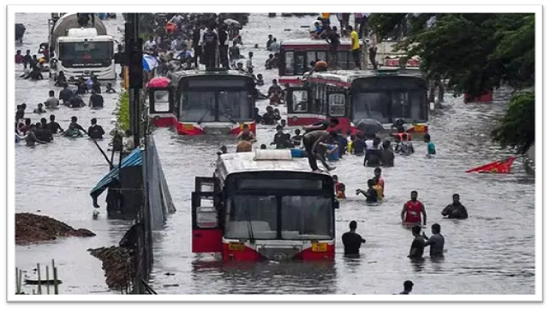
Mumbai Rains: Red Alert, Waterlogging, and the City’s Resilient Response
Mumbai once again demonstrated both the challenges of urban monsoons and the resilience of its civic machinery as heavy rains lashed the city early Monday morning. The India Meteorological Department (IMD) issued a red alert for intense rainfall with thunderstorms, urging citizens to remain cautious for the next few hours.
Despite severe waterlogging in areas like Bandra, Sion, Dadar, Andheri, Byculla, and Mahalaxmi, the city’s response mechanisms—from traffic management to emergency rescue—were activated swiftly. The events underscored the urgency of climate preparedness and the importance of coordinated action in an increasingly volatile monsoon environment.
The Scale of Rainfall and Its Immediate Impact
Mumbai woke up to torrential showers that disrupted road and rail traffic, leaving commuters grappling with delays and detours. According to early estimates, rainfall intensity in some parts of the city crossed 80 millimeters in just three hours, creating knee-deep water in several low-lying areas. The Andheri Subway was closed due to waterlogging, forcing vehicles onto alternate routes such as the Gokhale Bridge, which quickly became congested.
The Eastern Express Highway, one of Mumbai’s arterial roads, witnessed major traffic snarls around Sion and Kings Circle. Meanwhile, the Mumbai Monorail was stranded near Wadala after a technical issue, though fire brigade teams swiftly evacuated passengers without incident. On the Central and Harbour railway lines, train services were delayed by up to 15 minutes, with reports of track flooding at Kurla station. For a city where more than 7.5 million commuters depend on the suburban rail network every day, even short delays create widespread economic and logistical ripples.
Civic Response and Emergency Measures
The Brihanmumbai Municipal Corporation (BMC) issued an advisory urging citizens to avoid non-essential travel and to report civic issues through its emergency helpline. Pumping stations were activated to clear waterlogged roads, and disaster response teams were stationed at vulnerable spots across the city.
This reflects not only reactive governance but also years of investment in flood mitigation infrastructure. In recent times, the BMC has upgraded stormwater drainage systems, implemented flood forecasting models, and introduced digital platforms for real-time communication with residents. Monday’s response highlighted how these investments are beginning to translate into more coordinated crisis management.
Lessons from the Red Alert
The IMD’s red alert is more than a weather warning; it is a reminder of the relationship between urban planning, infrastructure resilience, and climate change. Mumbai, with a population of over 12 million, is particularly vulnerable to the monsoon’s intensifying rainfall patterns.
Yet what could be described as chaos also reveals progress. Unlike earlier years when flooding often caught the city off guard, today’s proactive alerts, coordinated traffic redirection, and transparent public communication show a city learning from past experiences.
Moving Towards a More Resilient Mumbai
Monsoons in Mumbai have always been both a test and a teacher. The disruptions witnessed on Monday highlight the need for continued investments in smarter infrastructure, wider use of technology in urban governance, and deeper citizen participation in disaster preparedness.
While heavy showers are expected to continue through the day, the collective response of citizens, civic authorities, and frontline workers is a reminder of Mumbai’s resilient spirit. The immediate challenge is to convert short-term responses into long-term strategies that make the city a model of climate adaptation for other Indian metros.
Key Takeaway
The heavy rains of Monday morning disrupted life but did not disable the city. With proactive governance, improved preparedness, and active citizen engagement, Mumbai is showing how an urban metropolis can adapt to the growing volatility of climate-driven monsoons. The red alert is not only a warning but also an opportunity to accelerate resilience and rethink urban futures.




